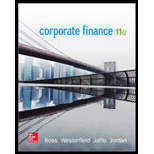
To critically think about: The reason why the stockholders’ of Company F would not suffer a loss despite the loss reported in the income statement
Introduction:
The income statement indicates the performance of an organization for a short period. The net income of the company will be positive if the net revenues exceed its expenses. It indicates profit for the financial period. The net income will be negative if the expenses exceed the revenues. It indicates a loss for the financial period.
Write offs refer to the
Cash flow refers to the difference between the money that actually flows in and out of the company. Cash flow ignores noncash items like depreciation. Depreciation is just an accounting value, and the depreciation expenses do not lead to any
Want to see the full answer?
Check out a sample textbook solution
Chapter 2 Solutions
Corporate Finance (The Mcgraw-hill/Irwin Series in Finance, Insurance, and Real Estate)
- What is the value of Ls stock for volatilities between 0.20 and 0.95? What incentives might the manager of L have if she understands this relationship? What might debtholders do in response?arrow_forwardIs the claim that lower company taxes adding to investments correct or is it debatable given the prediction on economic growth remains negative, and can you explain why? Your advise on this is ____________________ (provide your answer and justification. Feel free to use external resources to assist you in your answer if you prefer).arrow_forward2) __________ focus more on underlying determinants of future profitability than the past price movements of a firm's stock. A) Credit analysts B) Fundamental analysts C) Systems analysts D) Technical analysts Please justify your answer.arrow_forward
- Which of the following events would not improve (increase) a company’s return on equity? (Assume all else remains the same.) a. Retirement of long-term debt with cash b. Sale of common stock for cash c. Reduction in operating expenses Select one: b a and b a and c None of the events would improve a company’s return on equity. a c b and c plzz explain properlyarrow_forwardWhich of the following statements is correct? A. The optimal dividend policy is the one that satisfies management, not shareholders. B. The use of debt financing has no effect on earnings per share (EPS) or stock price. C. Stock price is dependent on the projected EPS and the use of debt, but not on the timing of the earnings stream. D. The riskiness of projected EPS can impact the firm's value. E. Dlvidend policy is one aspect of the firm's financial policy that is determined solely by the shareholders. Reset Selectionarrow_forward1) Do you feel about using financial statement analysis to evaluate an organization’s performance? 2) What are your view on analyzing investments using the equity methodology vs the market-value? 3) Are there any segments in chapter which are still unclear to you?arrow_forward
- 1. How do you think today's low interest rate environment is impacting the time value of money? How might this change the value of an asset or liability? 2. What is the relationship between the concepts of net present value and shareholder wealth maximization? 3. Offer some reasons that the intrinsic value that you might calculate with the methodologies learned might yield a price different than what the stock trades at in the stock market. You can reference any method of valuation models in offering thoughts on why there might be differences between intrinsic and market values.arrow_forwardChoose the correct. Which of the following is not included in the assumption on which Myron Gorden proposed a model on Stock valuation: A. Retained earning the only source of financing B. Finite Life of the firm C. Taxes do not exist D. Constant rate of return on firms investment.arrow_forwardExplain the effect of D/E on asset returns, equity returns (assuming that cost of debt is not affected), asset beta and equity beta (assuming that debt beta is zero). Should an investor choose to invest in a stock of a company with high or low D/E, or why expected returns on these stocks are equivalent, although they are not equal?arrow_forward
- Is this statement true or false? Give a reason for your answer. " Relevant or not, frequent changes in dividend policy can harm a firm."arrow_forward5. An optimal dividend policy is one that takes into consideration that:a) Dividends should only be distributed based on the profits of the last period.b) Dividends can be distributed even if the company recorded losses in the last period.c) The balance between current dividends and future growth is achieved, maximizing the value of the company.d) It manages to attract investors who have a predilection for relatively high risks.arrow_forwardWhich of the following best describes why the predicted incremental earnings arising from a given decision are not sufficient in and of themselves to determine whether that decision is worthwhile? ... O A. They do not tell how the decision affects the firm's reported profits from an accounting perspective. O B. They are not easily predicted from historical financial statements of a firm and its competitors. O C. They do not show how the firm's earnings are expected to change as the result of a particular decision. O D. These earnings are not actual cash flows.arrow_forward
 Survey of Accounting (Accounting I)AccountingISBN:9781305961883Author:Carl WarrenPublisher:Cengage Learning
Survey of Accounting (Accounting I)AccountingISBN:9781305961883Author:Carl WarrenPublisher:Cengage Learning Intermediate Financial Management (MindTap Course...FinanceISBN:9781337395083Author:Eugene F. Brigham, Phillip R. DavesPublisher:Cengage Learning
Intermediate Financial Management (MindTap Course...FinanceISBN:9781337395083Author:Eugene F. Brigham, Phillip R. DavesPublisher:Cengage Learning Financial Reporting, Financial Statement Analysis...FinanceISBN:9781285190907Author:James M. Wahlen, Stephen P. Baginski, Mark BradshawPublisher:Cengage Learning
Financial Reporting, Financial Statement Analysis...FinanceISBN:9781285190907Author:James M. Wahlen, Stephen P. Baginski, Mark BradshawPublisher:Cengage Learning- Business/Professional Ethics Directors/Executives...AccountingISBN:9781337485913Author:BROOKSPublisher:Cengage



